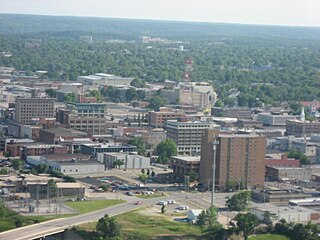
Joplin is a city in Jasper and Newton counties in the southwestern corner of the U.S. state of Missouri. The bulk of the city is in Jasper County, while the southern portion is in Newton County. Joplin is the largest city located within both Jasper and Newton Counties - even though it is not the county seat of either county. With a population of 51,762 as of the 2020 census, Joplin is the 12th most-populous city in the state. The city covers an area of 35.69 square miles (92.41 km2) on the outer edge of the Ozark Mountains. Joplin is the main hub of the three-county Joplin-Miami, Missouri-Oklahoma Metro area, which is home to 210,077 people making it the 5th largest metropolitan area in Missouri. In May 2011, the city was hit by a violent EF5 tornado.
Joplin Public Library District is the library services for Joplin, Missouri.
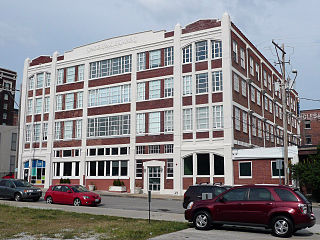
The Safeway Stores Office and Warehouse Building is a historic building near downtown Kansas City, Missouri. The building was designed by Kansas City architects Archer and Gloyd and was built by local contractor J. H. Thompson in 1929. It served as Safeway's regional produce and canned goods warehouse, as well as the regional headquarters for the chain. The warehouse served a region extending from Topeka, Kansas in the west to St. Joseph, Missouri in the north, Columbia, Missouri in the east to Joplin, Missouri in the south.

The Scott Joplin House State Historic Site is located at 2658 Delmar Boulevard in St. Louis, Missouri. It preserves the Scott Joplin Residence, the home of composer Scott Joplin from 1901 to 1903. The house and its surroundings are maintained by the Missouri Department of Natural Resources as a state historic site. The house was added to the National Register of Historic Places and designated a U.S. National Historic Landmark in 1976.

This is a list of the National Register of Historic Places listings in Jasper County, Missouri.

The Adrian Public Library is a historic structure located at 110 East Church Street in downtown Adrian, Michigan. Originally used as a library, it was designated as a Michigan Historic Site on December 14, 1976, and later listed on the National Register of Historic Places on December 6, 1977. It is located within the Downtown Adrian Commercial Historic District and adjacent to the Adrian Engine House No. 1. Today, the building houses the Lenawee County Historical Society Museum.

The Elks Club Lodge No. 501 is a historic Elks Lodge located at Joplin, Jasper County, Missouri. It was built in 1904–1905, and is a two-story brick and stone hip roofed building designed in Colonial Revival / Georgian Revival architectural styles. It measures 102 feet by 62 feet and features a columned portico flanked by two slightly projecting bays accentuated by limestone quoins.
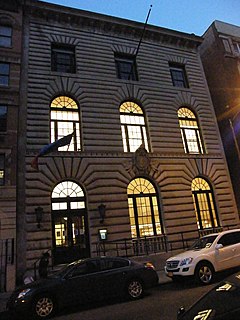
The Harry Belafonte 115th Street Branch of the New York Public Library is a historic library building located in Harlem, New York City. It was designed by McKim, Mead & White and built in 1907–1908 and opened on November 6, 1908. It is a three-story-high, three-bay-wide building faced in deeply rusticated gray limestone in a Neo Italian Renaissance style. The branch was one of 65 built by the New York Public Library with funds provided by the philanthropist Andrew Carnegie, 11 of them designed by McKim, Mead & White. The building is 50 feet wide and features three evenly spaced arched openings on the first floor.

The Hamilton Grange Branch of the New York Public Library is a historic library building located in Hamilton Heights, Manhattan, New York City. It was designed by McKim, Mead & White and built in 1905–1906. The branch was one of 65 built by the New York Public Library with funds provided by the philanthropist Andrew Carnegie, 11 of them designed by McKim, Mead & White. It is a three-story-high, five-bay-wide building faced in deeply rusticated gray limestone in an Italian Renaissance style. The building features round arched openings on the first floor and bronze lamps and grilles.

St. Peter the Apostle Catholic Church and Rectory is a historic Roman Catholic church and rectory located at 812 Pearl Street in Joplin, Jasper County, Missouri. The church was built in 1906, and is a Late Gothic Revival style building constructed of Carthage limestone. It measures 63 feet, 6 inches, by 122 feet, 8 inches and features circular windows; tracery; Gothic arched windows and doors; and the triple portal entry. The rectory was built in 1917, and is a two-story Prairie School style dwelling with a finished basement. It is constructed of Carthage limestone and has a low pitched, hipped roof with wide overhang. Also on the property is a contributing concrete block garage.
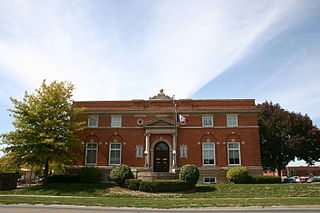
Oskaloosa Public Library is a facility located in Oskaloosa, Iowa, United States. Construction of the library was launched in 1902 with a grant from the Carnegie Corporation of New York. The building was added to the National Register of Historic Places in 1991.
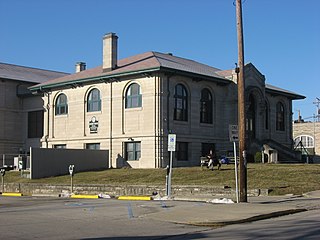
Monroe Carnegie Library, also known as Old Monroe Carnegie Library, is a historic Carnegie library located at Bloomington, Monroe County, Indiana. It was built in 1917, and is a one-story, rectangular, Neoclassical style limestone building on a raised basement. The Monroe County History Center is a history museum the historic library building that was established as a Carnegie library. The museum is located on the site of Center School in the former Bloomington Public Library building. The library building is now home to the Monroe County Historical Society, their collection of artifacts, and their Genealogy Library. A historical marker is present at the site. The History Center is located at 202 East 6th Street. It is a tourist attraction.

Olivia Apartments is a historic apartment building located at Joplin, Jasper County, Missouri. It was built in 1906, and is a five-story, "U"-shaped, red brick building. It measures approximately 100 feet by 125 feet and features Bedford limestone ornamentation and light colored brick cross hatching.
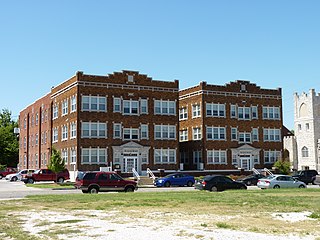
Ridgway Apartments, also known as North Ridgeway Apartments & South Ridgeway Apartments, are two historic apartment buildings located at Joplin, Jasper County, Missouri. They were built in 1918, and are three-story, rectangular brick buildings. Each measures approximately 42 feet by 125 feet and feature centrally placed entrances embellished with a prominent pediment surround and stepped parapets that crown the main facade.

Rains Brothers Building, also known as Miner's Hardware Company and Roosevelt Hotel, was a historic commercial building located at Joplin, Jasper County, Missouri. It was built in 1900–1901, and was a three-story, three bay, two-part commercial building with Renaissance Revival style detailing. It was destroyed by fire on March 1, 2012.

St. Louis and San Francisco Railroad Building, also known as the Frisco Building, is a historic train station and office building located at Joplin, Jasper County, Missouri. It was built in 1913 for the St. Louis and San Francisco Railroad, and is a nine-story, "L"-shaped, brick and stone trimmed building with a decorative cornice. It measures approximately 101 feet by 127 feet and has a two-part vertical block form.

Sedalia Public Library is a historic Carnegie library building located at Sedalia, Pettis County, Missouri. It was designed by the architecture firm Shepley, Rutan and Coolidge and built in 1900. It is a two-story, cruciform plan, Greek Revival style wood and steel frame building with brick walls and limestone and terra cotta facing. It is seven bays wide with an open tetrastyle Ionic order portico on the front facade. It was the first public library in the state of Missouri to receive a Carnegie grant for construction of a library building. The grant was $50,000.
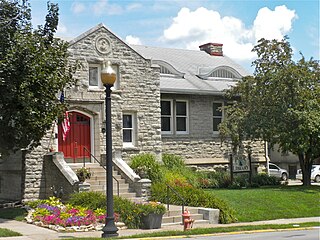
Louisiana Public Library is a historic Carnegie library building located at Louisiana, Pike County, Missouri. It was designed by the architectural firm Mauran, Russell, and Garden and built in 1905. It is a one-story, Late Gothic Revival style rock-faced, cut limestone building on a partially exposed basement. It measures approximately 50 feet by 40 feet and features a front arched doorway with batten doors, eyebrow windows, and stepped parapet. It was constructed with a $10,000 grant from the Carnegie Foundation.

Bolivar Public Library, also known as the Carnegie Library of Bolivar and Polk County Genealogical Society Library, is a historic Carnegie library located at Bolivar, Polk County, Missouri. It was built in 1915, and is a 1 1/2- to two-story, rectangular, brick building with Classical Revival style design elements. It has a flat roof and three bay front facade with an elaborate center entranceway and large side window bays. It features intact terra cotta and tooled limestone ornamentation. It was funded by an $8,000 Carnegie grant from the Carnegie Foundation. The property was listed on the National Register of Historic Places in 2003.

The Woman's Club of Olympia was founded in Olympia, Washington, United States, in 1883. It is one of the oldest woman's club on the West Coast. Founding members included Mehitable Elder, Pamela Case Hale, Mary Hartsock, Janet Moore, Phebe Moore, Mary Shelton, Ella Stork, Abbie Howard Hunt Stuart, and Sarah E. Whitney. Its first president, Mrs. A.H.H. Stewart, a college graduate and a veteran of the Women's Club in Boston, was a "driving force" in the club's organization and was known as the "Mother of Women's Clubs" for having founded other clubs, too.























